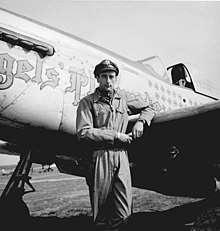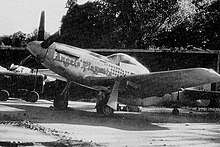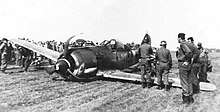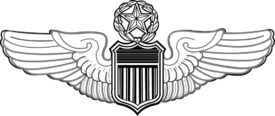Bruce W. Carr
Bruce Ward Carr (January 28, 1924 – April 25, 1998) was a highly decorated United States Air Force colonel. During World War II, he was shot down over Germany and, after evading capture for several days, snuck into a Luftwaffe airfield and stole an enemy plane which he flew back to Allied lines. He also became a flying ace credited with 14 or 15 aerial victories, including five in a single day, for which he was awarded the Distinguished Service Cross.
Bruce Ward Carr | |
|---|---|
 | |
| Born | January 28, 1924 Union Springs, New York |
| Died | April 25, 1998 (aged 74) St. Cloud, Florida |
| Buried | |
| Allegiance | |
| Service/ | |
| Years of service | 1942–1973 |
| Rank | |
| Battles/wars | World War II Korean War Vietnam War |
| Awards | Distinguished Service Cross Silver Star Legion of Merit Distinguished Flying Cross (4) Air Medal (31) |
Early life and World War II
Bruce W. Carr was born on January 28, 1924, in Union Springs, New York.[1] He began flying at the age of 15 in 1939, and enlisted into the United States Army Air Forces on September 3, 1942. Carr entered the Aviation Cadet Training Program, where his military flight instructor happened to be the very same person who taught him to fly in 1939.[2][3]
Due to his previous flying experience, Carr was placed in an accelerated training program, flying the P-40 Warhawk at Spence Field, Georgia. Acquiring over 240 flight hours, Carr was promoted to flight officer on August 30, 1943.[2]
Carr deployed to Europe in February 1944, where he was assigned to the 380th Fighter Squadron, 363rd Fighter Group, Ninth Air Force, at RAF Rivenhall in Essex, England. The 363rd was one of the first units to adopt the P-51 Mustang. Carr had never flown above 10,000 feet, but when he took the P-51 to an altitude of 30,000 feet, he was duly impressed and named his plane "Angel's Playmate."[2][3]
Ace status

On March 8, 1944, Flight Officer Carr scored his squadron's first kill, however, he was not given credit for it. Carr chased a German Me109 to within a few feet off the ground, firing his guns the whole time. Only one bullet hit the enemy plane, and the pilot bailed out far too close to the ground and crashed. Carr said he scared the German pilot to death and caused him to kill himself.[2][3]
Upon returning to the airfield, Carr was criticized by his leaders for being "overaggressive." In May, he was transferred to the 353rd Fighter Squadron, 354th Fighter Group, at RAF Lashenden in Kent. Claiming a probable kill over Normandy, France, on June 14, Carr scored his first official credit on June 17, when he assisted another pilot in downing an Fw190. The next day, the squadron transferred to an airfield in France. On August 18, Carr was commissioned as a second lieutenant.[2]
On September 12, Second Lieutenant Carr's flight strafed several Junkers Ju-88 bombers on an airfield in Germany. Later in that same mission, the flight spotted over 30 Fw190s approximately 2,000 feet below them. Carr personally shot three from the sky before escorting a fellow pilot, whose aircraft was badly damaged, back to base. Carr was awarded the Silver Star for his actions that day.[2]
Shot-down over Germany
On October 29, Carr shot down two more Me109s and claimed ace status while on a strafing mission over Germany. Four days later on November 2, Second Lieutenant Carr led his flight on another strafing mission over a German airfield in Czechoslovakia. Carr's P-51 was struck by anti-aircraft fire and he was forced to bail out. He evaded capture for several days until he was physically exhausted, starving, and suffering from exposure to the elements. Carr decided it was better to surrender to the Germans rather than be captured.[2][3][4]

Carr went to a nearby enemy airfield to turn himself in when he observed a ground crew fueling and arming an Fw190 on the airstrip. Once the crew left, Carr snuck through a fence and climbed into the cockpit. He spent the night familiarizing himself with the controls of the Fw190, which were all labeled in German. At dawn, Carr started up the engine and took off from the airfield with no resistance from the enemy.[2][3][4]
When Carr reached friendly lines, Allied troops mistook the Fw190 he was flying for an enemy plane and opened fire. To avoid being hit from friendly fire, he flew just above the treetops at 350 miles per hour. After flying 200 miles, he arrived at his home airfield. Unable to deploy his landing gear and with no radio to communicate that he was friendly, Carr made a belly landing in order to avoid being shot down by his own air defenses.[2][3][4]
Carr's Fw190 was surrounded by military policemen, and he was unable to convince them he was with the 354th. However, his group commander soon arrived and recognized Carr. Carr is the only Allied pilot known to leave on a mission flying a P-51 and return in an Fw190. He was promoted to first lieutenant and then went on leave on November 15.[2][3][4]
Further war service
On April 2, 1945, First Lieutenant Carr was leading three other aircraft on a reconnaissance mission near Schweinfurt, Germany, when he spotted 60 German fighters flying above them. Despite the enemy having an altitude advantage and outnumbering them, Carr led his flight in an attack and the pilots downed a total of 15 aircraft. Carr personally shot down two Fw190s, three Me109s and damaged a sixth fighter. This feat made Carr the last ace in a day in the European Theater during the war and he was awarded the Distinguished Service Cross for his actions.[1][2][4][5]
Carr was promoted to captain on April 9, and claimed several more aerial victories that month, claiming two final victories on April 25. Carr flew a total of 172 combat missions during the war, accumulating 14[6] or 15[1] confirmed air-to-air victories. He had several more unconfirmed victories and multiple ground kills.[2]
Later career and life
After the war, Carr was assigned to the Acrojets as an F-80 Shooting Star pilot at Williams Air Force Base, Arizona. The Acrojets, which preceded the Thunderbirds, were the United States Air Force's first jet-powered aerobatic demonstration team.[1][2]
Major Carr later flew the F-86 Sabre in 57 combat missions with the 336th Fighter-Interceptor Squadron during the Korean War. He then served as the commanding officer of the 336th at Misawa Air Base, Japan, from January 1955 to August 1956.[2]
On November 3, 1968, Carr was promoted to colonel, and deployed to Vietnam later that month. Colonel Carr was assigned to the 31st Tactical Fighter Wing at Tuy Hoa Air Base, South Vietnam. He flew the F-100 Super Sabre in 286 combat missions during the war, which mostly consisted of flying close air support bombing and strafing missions. Carr was awarded the Legion of Merit and three Distinguished Flying Crosses during his deployment before he rotated back to the United States in November 1969.[1][2]
Colonel Carr retired from the Air Force in 1973. Bruce W. Carr died of prostate cancer on April 25, 1998, in St. Cloud, Florida. He was buried in Arlington National Cemetery.[2][7]
Awards and Decorations
His awards include:
 |
US Air Force Command Pilot Badge |
| Distinguished Service Cross | |
| Silver Star | |
| Legion of Merit | |
| Distinguished Flying Cross with Valor device and 3 bronze oak leaf clusters | |
| Air Medal with two silver and two bronze oak leaf clusters | |
| Air Medal with silver and three bronze oak leaf cluster (second ribbon required for accouterment spacing) | |
| Air Medal (third ribbon required for accouterment spacing) | |
- unit and campaign decorations
Distinguished Service Cross citation

- Carr, Bruce W.
- Lieutenant Colonel (Air Corps), U.S. Army Air Forces
- 353rd Fighter Squadron, 354th Fighter Group, 9th Air Force
- Date of Action: April 02, 1945
- Citation:
The President of the United States of America, authorized by Act of Congress July 9, 1918, takes pleasure in presenting the Distinguished Service Cross to First Lieutenant (Air Corps) Bruce Ward Carr (AFSN: FR-16522/ASN: 0-887280), United States Army Air Forces, for extraordinary heroism in connection with military operations against an armed enemy while serving as Pilot of a P-51 Fighter Airplane in the 353d Fighter Squadron, 354th Fighter Group, Ninth Air Force, in aerial combat against enemy forces on 2 April 1945, in the European Theater of Operations. On this date, while leading four aircraft on an armed reconnaissance mission near Schweinfurt, Germany, Lieutenant Carr observed more than sixty enemy fighters flying high above. Completely disregarding his personal safety and the enemy's overwhelming numerical superiority and tactical advantage of altitude, he led his element in a direct attack on the hostile force, personally destroying five enemy aircraft and damaging still another. The extraordinary heroism and determination of this officer to destroy the enemy are in keeping with the highest traditions of the Armed Forces of the United States.[8]
References
- "Bruce Ward Carr". Military Times.
- Scott Baron. "Valor of Many Stripes: Remarkable Americans in World War II".
- "Bruce Carr". rb-29.net.
- "Valor: Thanks, Luftwaffe". Air Force Magazine.
- Arthur Wyllie. "Army Air Force Victories".
- "Guide to Aces and Heroes" (PDF). 2014 USAF Almanac.
- "Bruce Ward Carr". Find A Grave.
- "Valor awards for Bruce Ward Carr". valor.militarytimes.com. Retrieved 2018-10-10.